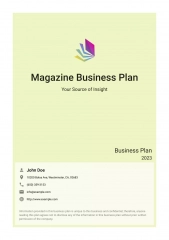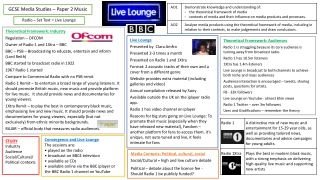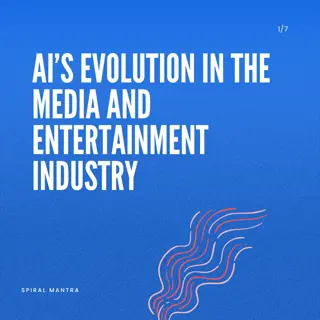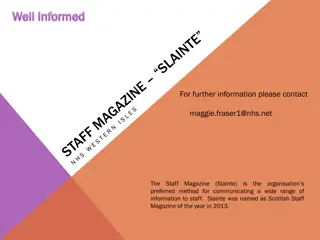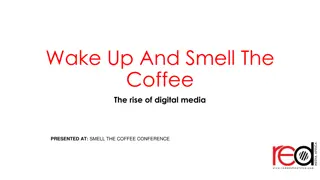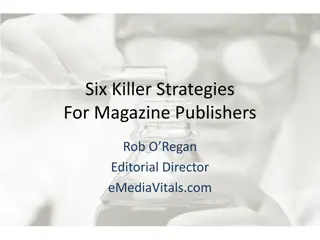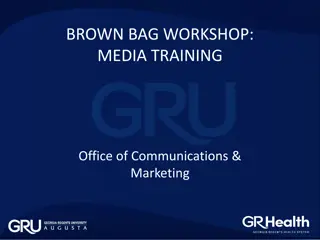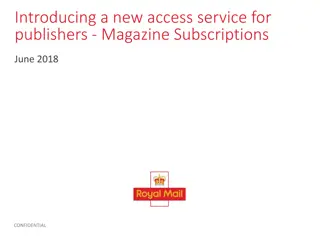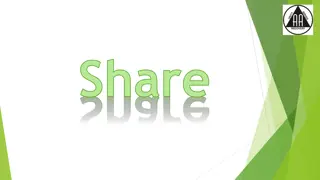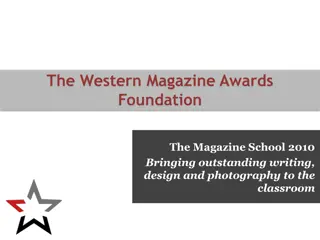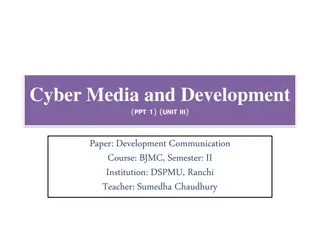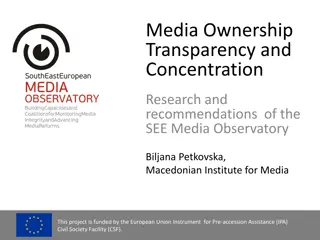Evolution of the Magazine Industry: Trends and Challenges in Media Landscape
The magazine industry has undergone significant transformations since the 1960s, with major shifts in publishers, readership preferences, and the rise of digital platforms. Today, major publishers still dominate, but niche magazines with unique identities are thriving. Key theories like semiotics, representation, and industry dynamics play crucial roles in analyzing media content and audience engagement.
Download Presentation

Please find below an Image/Link to download the presentation.
The content on the website is provided AS IS for your information and personal use only. It may not be sold, licensed, or shared on other websites without obtaining consent from the author.If you encounter any issues during the download, it is possible that the publisher has removed the file from their server.
You are allowed to download the files provided on this website for personal or commercial use, subject to the condition that they are used lawfully. All files are the property of their respective owners.
The content on the website is provided AS IS for your information and personal use only. It may not be sold, licensed, or shared on other websites without obtaining consent from the author.
E N D
Presentation Transcript
EDUQAS A Level Media EDUQAS A Level Media Component 2 Section B Codes and conventions Publishers Demographics Ownership Psychographics Conglomerate Circulation Cultivation Readership Niche/mass audience House style Ethos/ideology Reception Intersectionality Print and digital Brand identity Interactivity Star persona Prosumer Uses and Gratifications Data mining The 4 C s
The magazine industry has changed significantly since the 1960s when the historical set products were published. The marketplace was less crowded and the industry was dominated by a small number of major publishers. Today, the industry is still dominated by major publishers (such as Hearst, IPC, Bauer) but there is a much wider range of titles available and much greater competition for readers. Print circulation is falling and there has been a rise in digital sales. Magazines need a strong online and social media presence as well as a clear, unique brand identity, in order to compete many titles, such as Nuts and Loaded, have closed in recent years, and others, such as Company, have become online-only magazines. Woman s Realm merged with Woman s Weekly in 2001 as, according to research by IPC, it no longer reflected the financially independent lives of its target readership . Many mainstream lifestyle magazines have struggled to survive, however there is now a wider range of niche, or specialised, magazines available and those that have developed a unique selling point and secured a loyal audience have been able to succeed. Magazine Magazine Industry Industry Overview Overview https:/www.them ediabriefing.com /article/do- magazine-covers- still-count SECTION 1 INTRODUCTION to Magazines
Key theories to apply in this unit: LANGUAGE Semiotics (Barthes) Structuralism (Levi-Strauss) REPRESENTATION Representation (Hall) Identity (Gauntlett) Feminist (Van Zoonen and bell hooks) INDUSTRY Power and Media (Curran & Seaton) Regulation (Livingston & Lunt) Cultivation (Gerbner) Reception (Hall)
[Application of key theory] LANGUAGE REPRESENTATION INDUSTRY Semiotics Denotation Representation Gender/class/race/sexuality/ethnicity Power & Media Conde Nast ownership Vogue Connotation Effect Identity Brand ethos Cultivation Patterns of representation Structuralism Denotation Fem (VZ) Waves of feminism Reception Preferred Negotiated Oppositional Connotation Effect Fem (bh) Intersectionality Regulation IPSO Defunct PCC Semiotics Denotation Representation Gender/class/race/sexuality/ethnicity Power & Media Non-mainstream ownership The Big Issue Connotation Effect Identity Brand ethos Cultivation Patterns of representation Structuralism Denotation Fem (VZ) Waves of feminism Reception Preferred Negotiated Oppositional Connotation Effect Fem (bh) Intersectionality Regulation IPSO Defunct PCC
The PRIDEMAGAZINE.COM hyperlink features above the masthead as a web address which highlights the magazine s modern appeal and for readers to access for additional content or an online version of the magazine. It shows that there are multiple methods of accessing magazine content. EXAMPLE ANSWER The strapline Celebrating 26 years at the top! features on the top left above the masthead. This reinforces the magazine s long-term success as a leading representative for Black British women. Readers are reassured by the magazine s proven track record, which makes it more appealing. The PRIDE masthead is positioned at the top of the page, written in turquoise uppercase text. The masthead suggests that the magazine has a sense of confidence in its identity. The effect on the reader is identification and inclusion, particular for the magazine s target audience: Black British women. The dateline November 2017 shows that this is a recent issue and the 3 priceline also illustrates that this is an affordable magazine for its target audience. The Cost of Standing Up To Racism coverline in blue uppercase font represents one of the magazine s key values: pride in racial identity and rebuking racism. The effect on the reader is to challenge them to respond actively to a major issue in society. Confessions of a Black Actress coverline reinforces the magazines two main themes: racial and gender identity. The audience will enjoy the personal nature of these articles, highlighted by the term Confessions . The direct address black and white photography anchoring image of Naomi Campbell features her looking over her shoulder wearing a fur coat with her hair pulled back shows a confident Black British celebrity (fashion model) who acts as a role model for the target audience. PRIDE intend to celebrate Campbell s success and show her as an example of what readers can also achieve. The 101 ways to Stand Up and Be Heard coverline emphasises a key idea for the magazine: pride, self- esteem, confidence and courage. The quantity of ideas will appeal to readers who can appreciate the amount of options they have to make an impact. The coverline How healthy is your makeup bag? . shows that the magazine wishes to cater for fashion and beauty enthusiasts and encourage further consumerism. It challenges readers to self-evaluate. The coverline: Hair: Liven up your winter with colour (which is written in white and orange cursive font) highlights the magazine s interest in fashion and beauty. It shows that PRIDE realises that its target audience are interested in hairstyles, and provides them with ideas in order to encourage diverse creativity with fashion. The main coverline Naomi speaks out is written in gold cursive font and shows that the magazine wants to give the fashion icon a platform to share what matters to her. It encourages readers to find platforms themselves as Naomi and the magazine clearly want to empower other black British women. The bar code features on the bottom right of the page. This shows that this version of the magazine is the print edition. This magazine has a readership of 250,000 every year which shows it is popular. The sub-heading on diversity, acting and being herself highlights how the magazine is interested in the star s response to her racial identity, what it is like to be a celebrity and how to remain authentic in such a competitive world. The reader will appreciate the down-to-earth approach of the magazine which hopes to reveal the real Naomi behind the media persona. Extended analysis: C&C design, the magazine s ideology, the overall aesthetic, social/historical context of the magazine, the impact of its representations, industry information.
The Big Issue The Big Issue Component 2 Section B Industry research task: The Big Issue - http://www.bigissue.com (Dennis Publishing). Is the publisher a mainstream organisation or independent publisher? Is the publisher part of a media conglomerate? What other products does the organisation produce? How is this significant for the magazine? Publishers: Weekly by Dennis & The Big Issue Ltd (1991-). Set edition: October 17-23 2016 Issue number: 1227 Price: 2.50 Circulation: 82,000 readership Genre: Independent/ current affairs/ entertainment/ street magazine. Tagline: A hand up not a handout Review: From an award- winning magazine offering employment opportunities to people in poverty, to a multi-million pound social investment business supporting enterprise to drive social change. For over 25 years The Big Issue Group has strived to dismantle poverty through creating opportunity, in the process becoming one of the most recognised and trusted brands in the UK. Brand identity Task: http://www.bigissue.com/about/, http://www.bigissue.com/advertising/ What do the above pages reveal about: The brand identity, including the ethos of The Big Issue? The unique nature of the distribution model? The associated organisation The Big Issue Foundation. Analytical task: How is this brand identity and ethos evident in the set edition of The Big Issue? Research Task: Access the following websites: https://goo.gl/EHLBHM, https://goo.gl/1eiGyF, https://goo.gl/ZZKBwQ, https://goo.gl/FGdZEQ Summarise the following points: How the brand identity has developed over time. How the magazine maintains an audience. How the magazine achieves success when many other magazines are in decline
Issue, dateline, priceline Strapline Aesthetic and composition Masthead Historical and industry context Anchoring image/typography Demographics, psychographics Secondary leads Representation
The Big Issue - A Hand Up, Not a Hand Out https://gb.zinio.com/www/browse/product.jsp?rf=sch& productId=500940522#/ The Big Issue is a UK-based street paper that supports the homeless, the vulnerably housed and those seeking to escape poverty. Vendors normally buy the magazine for 1.25 and sell to the public for 2.50. We are using Zinio digital editions to create additonal revenue opportunities to fund our street-based and pastoral care services for our vendors. We are a social enterprise company and all revenues go to support the vulnerable communities we serve. Our goal is to move our vendors away from dependency and towards full time employment. Website Website - - www.bigissue.com www.bigissue.com How does the website reinforce the brand identity of the magazine? Is there a clear house style that is evident across the magazine and the website? What does the website offer that is different from the content of the magazine? How does the website extend the brand (e.g. through videos, merchandise etc.)? How does your magazine use social media (e.g. to market the latest edition or offer additional content)? How can readers interact with the magazine through the website and social media? Suggestions: Global reach available worldwide Huge range of titles (6000+), some mainstream some niche/ independent, so readers may subscribe to one magazine and find out about others through Zinio 10 million readers maximising audience reach Availability to download onto almost any digital device maximising potential audience reach Zinio offers single issue or subscription allows readers the chance to read one copy and then subscribe if they want to The Big Issue uses revenue from digital sales to fund further support for vendors, as a social enterprise organisation Suggestions Appeal to audiences, who can access a much wider range of associated additional content, such as videos, online Online versions of magazines offer numerous opportunities for audiences to interact and become more loyal to the brand, including encouragement to follow on social media Regular updates mean that readers don t have to wait until the next edition is published Publisher can reinforce its brand values by, for example, offering additional features on specific topics Publisher can offer prominence to specific advertisers Big Issue - digital and print editions, print magazine offers long form journalism and reportage not included on website, tells an outsider story and features voices.. rarely heard in main media , a combination of current affairs and popular cultural/ entertainment features, content is not easily replicated, clear ethos/ social conscience unique in the magazine marketplace, not a luxury brand but a clear sense of identity.
Vogue (July 1965) Vogue (July 1965) Publisher: monthly by Cond Nast, 1916 to present. Set edition: July 1965 Price: 3 shillings (36 old pennies) Historical Context: Women s magazines became very popular in the post-war period and, in the 1960s, sales of women s magazines reached 12 million copies per week. Industry context: - Vogue published by Conde Nast, a major mainstream publisher, established in the USA in 1909. - In 1959, the company was bought by Samuel I Newhouse, a newspaper owner as part of his media company Advance Publications. - In the 1960s Conde Nast began publishing Vogue in a number of different countries (British Vogue had been published since 1916). Current magazine: http://www.condenast.co.uk/vogue Genre:women s fashion magazine: monthly glossy . Features: high production values, aspirational, primarily focused on fashion, style, beauty, design, also cultural focus (theatre, books etc.). The set edition includes a range of articles about travel, money etc. features of broader lifestyle. Oppositional reading: it could be argued, can be seen to uphold many traditional ideologies surrounding gender (in relation to domesticity, motherhood, fashion and beauty for example) and perpetuate many narrow and stereotypical ideals of feminine beauty. Industry research task: Cond Nast http://www.condenastinternational.com/heritage/hi story/ Key questions: Is the publisher a large/mainstream organisation or an independent publisher? Is the publisher part of a media conglomerate? What other products (magazines or other media products) does the organisation produce? How is this significant for the magazine? Research Task: Access the following websites: https://goo.gl/CEyf4x https://goo.gl/xtHMez https://goo.gl/WELQPc Summarise the key points relating to why Vogue has attracted and maintained an audience for over 100 years. History of Vogue: Task: Watch the following video clip: https://goo.gl/UTVcmv Identify: What makes the Vogue brand unique? How has the brand changed over time? What changes in particular occurred in the 1960s? Discuss how the context of the 1960s is evident in the set magazine.
Masthead and aesthetic Brand identity Ownership Dateline/priceline Anchoring image Cover lines Historical context Representation of gender, ethnicity, class Industry context Demographics/psychographics
The heyday of the magazine came in the early 20th century, when mega- publisher William Randolph Hearst launched Harper s Bazaar, Good Housekeeping and National Geographic. Female-targeted Vogue and Vanity Fair followed, bringing fashion and women s issues to the forefront of popular culture. Time was founded in 1923. The 30s brought about aspirational magazines like Esquire and Fortune. Widely popular, topical publications directed at niche audiences rolled out in the 40s and 50s, including Sports Illustrated and Rolling Stone. The 60s and 70s gave us the celebrity- and entertainment-focused magazines People and Cosmopolitan. In the following decades, magazines diversified, with The Face debuting in 1980, Entertainment Weekly in 1990, Wired in 1993. The late 1990s and 2000s brought about the digital revolution. But while newspapers have suffered steep declines amid the ride of the Internet, magazines are another story. Across the industry, subscriptions are down, but the picture is more complicated than the overarching numbers suggest. Magazines aren t dying. About 190 new titles launched in 2014, up from 185 in 2013, according to database MediaFinder. While some legacy publications are struggling to keep their readers, magazines like Glamour, Parents and Better Homes and Gardens all reported increases in paid and verified circulation from 2013 to 2014. Source 1: Source 1: Article Article from from Huffington Huffington Post Post SECTION 1 INTRODUCTION to Magazines
Source 3: Extract from Source 3: Extract from Inside Magazine Publishing Publishing by David Stam and Andrew Scott by David Stam and Andrew Scott Inside Magazine Size of the Market While the magazine market is under attack from some powerful commercial organisations, it is important to be clear that the UK magazine market remains a major media sector and industry in its own right. Combined research for Inside Magazine Publishing estimates that annual value of the magazine industry in 2012 to be 3.55 billion. This is split as follows: - Consumers spend 1.8 billion on magazines at retail or via subscriptions. - Print magazine advertising totals a further 750 million. - Content marketing agencies (the producers of customer magazines) contribute a further 1 billion. - There are in excess of 2,400 consumer magazines. SECTION 1 INTRODUCTION to Magazines
The 1960s was a decade of great change in British society. Following the post-war period of austerity, the economy was growing and employment rates were high. This led to a growth in the consumer goods market, an increase in the number of people travelling abroad and an explosion in popular culture. Socially, traditional boundaries relating to social class and gender were shifting, and the feminist and civil rights movements had a significant impact on British society. It would be helpful for learners to gain an understanding of the social/ cultural context of their historical magazine. The following links provide a range of articles that give general background context to the 1960s. These are not included in the learner resources as teachers may wish to direct learners to specific sources that are relevant to their chosen historical magazine. Introduction to Introduction to historical/social/ historical/social/ cultural contexts cultural contexts for historical for historical magazines magazines Listen to the audio extract: The Changing Role of Women in the 1960s BBC History File http://www.bbc.co.uk/programmes/p00wfrgf http://www.bbc.co.uk/history/british/modern /overview_1945_present_01.shtml http://www.telegraph.co.uk/news/uknews/th e_queens_diamond_jubilee/9288411/The- DiamondDecades-The-1960s.html https://corporate.uktv.co.uk/news/article/swi nging-sixties/ All of the historical magazines are women s magazines, and so an understanding of women s roles in 1960s society would be helpful. The following BBC2 History File extract gives a concise contextual overview of some of the key issues and there is a digital resource The Changing Role of Women in the 1960s to accompany it. SECTION 1 INTRODUCTION to Magazines
Extended Task Extended Task How do these issues relate to your set historical magazine (Vogue, Woman orWoman s Realm)? Key points: Increased opportunities for women to have jobs be more than wife or mother. Developments women attending university intellectual and financial freedom greater expectations. Woman realised they were being badly treated not paid the same as men for example. Advertisements criticised for offering a limited view of women. Betty Friedan (American feminist) women are shown solely as: men s wife, mother, love object, dishwasher, cleaner and never as a person . Women s rights hot news by the end of the 1960s women s liberation movement shocking for some. Demands for equal pay/ opportunities protests/ marches. Advertisers unsure how to react to the women s movement advert for intercity women singing about their rights - but heading home before their husbands find out. SECTION 1 INTRODUCTION to Magazines
Historical magazines Historical magazines Women s magazines became very popular in the post-war period and, in the 1960s, sales of women s magazines reached 12 million copies per week. While this was a period of great change and increased independence for women, many magazines and adverts continued to perpetuate narrow and stereotypical ideas about gender. The representations in women s magazines should be analysed in relation to: the genre (and ideologies of consumerism driven by the need to deliver readers to advertisers) the social, cultural and historical context (the feminist movement in particular) This short video about the history of Vogue provides some useful context for all of the women s magazines: http://www.vogue.co.uk/video/inside-british-vogue-a-brief-history-of-100-years/ 1960s cultural change, swinging 60s 70s-80s second wave feminism women having it all SECTION 3 REPRESENTATIONS
Other sources Other sources 3a) The Historical contexts of representation resource is focused on the Vogue Money Q&A article this is excellent in terms of highlighting some of the legal constraints on women in the 1960s and it will be useful for all learners to read this article. - The digital resource is a highlighting exercise to identify some key representational and contextual points, and a written task. - This same activity could be used for the editor s letter page of Woman or Woman s Realm (page 3 in both magazines). There is a digital resource for analysing advertising in each of the historical magazines: 3b) Vogue 3e) The Theoretical Approaches 1 stereotyping in historical magazines resource includes an activity where learners apply ideas from Hall and Gauntlett to key examples from their set magazine. This could be repeated with other examples from the magazine. 3f) The Theoretical Approaches 2- feminist perspectives resource considers more advanced ideas and includes some links to articles relating to the ideal woman and Friedan s Feminist Mystique while these are American sources, they have relevance in relation to the British magazines. The tasks require learners to apply key feminist ideas to the magazine they have studied and to rank these in order of helpfulness in understanding the representations. Learners could focus on one key element of the magazine here (perhaps dividing the content between groups of learners) or look at the magazine holistically. Van Zoonen is included here, along with other ideas specifically related to women s magazines. 3i) The Big Issue: Moving On pages 33-34 SECTION 3 REPRESENTATIONS
Industry Context Industry Context 1960s magazine industry context women s magazines these links are not included in the student resources as they provide background information and teachers can decide if/ how they wish to use them. Overview/ history of women s magazines: https://www.theguardian.com/books/2008/dec/20/women-pressandpublishing General summary of the magazine industry in the 1960s to give some industry context. https://goo.gl/CF00vh (Inside Magazine Publishing by David Stam and Andrew Scott: 1960s industry developments pages 27-29) b) Current state/ future of the magazine industry - The digital resource How can magazines survive in the current climate? sets tasks for learners to consider the current state of the industry and the ways in which magazines can be successful. - The extract from The Media Show on Radio 4 gives a good insight into current issues for the industry. The focus is on Cosmopolitan and Vogue but the issues raised are relevant to the nonmainstream magazines set for A level. The information about Vogue would also be interesting for learners who are studying this magazine as a historical product. SECTION 4. INDUSTRY
Contemporary non Contemporary non- -mainstream magazines (A level only) mainstream magazines (A level only) c) The impact of digital technology on magazine production and distribution the following is available as a digital resource and is relevant to the contemporary non- mainstream magazines. Producing a digital edition of a magazine poses challenges for publishers as the technology required to create a digital edition is different to that required for print so, if the content is going to work on a digital platform, it requires a big investment. Digital circulation of magazines is growing, however currently accounts for a very small percentage of overall magazine circulation. According to the Press Gazette (pressgazette.co.uk) e) Magazines and advertising (historical and contemporary magazines) Magazines generate revenue primarily through sales of copies (print and digital) and through advertising. Advertising accounts for approximately one third of total revenues across the industry. It is, therefore, vitally important that the magazine and advertising content target the same audience in order that the advertising brands benefit from increased sales as a result of advertising in the magazine. period a year ago). Digital magazines accounted for 2.5 per cent of the total circulation audited by ABC in the second half of 2016. Digital editions (defined by ABC as digital versions which largely replicate the print edition) accounted for a further 1m in circulation (up from 750,000 in the same
Item about magazines - current state of industry - print v digital Print succeeding in some areas - luxury end of market e.g. Vogue celebrated 100 years with biggest ever issue, Cosmopolitan has quadrupled its sales figures. Some magazines are in decline e.g. In Style and other weeklies are struggling, described as suffering from a reader and advertiser exodus . Major problem so much free content on line the content featured n many magazines is easily replicated. Cosmo eco-system - ad revenue important, most still from print but also from other platforms e.g. snapchat. Events - live experience of Cosmo Cosmo dropped price to 1 - millennials expect to get content for free Website - not dig or print its dig and print - content online is v different to mag - mag has longer articles, reportage, different content Vogue - 100th anniversary creates expectation, like opening a present can t be replicated online - advertisers high-end, don t want to advertise online e.g. adblocking, want to work in print Lean back experience can t replicate the experience of leaning back and relaxing with a print magazine premium publishers need to emphasise that unique experience. More advertising in Vogue than before 36000 full page advert A lot of mags - glossies - not doing very well. Print transitioning - will survive - people willing to pay for some magazines, but those that replicate what s online won t survive Media Show Media Show 23/11/2016 23/11/2016 9.25 to 17.40 9.25 to 17.40 Questions Why are some magazines, particularly fashion magazines and weeklies, in decline? How has Cosmopolitan succeeded in increasing its circulation? How can magazines increase advertising revenue across different platforms? Why do some advertisers prefer to advertise in print publications than online? How can premium publishers maintain an audience for print magazines? What is the lean back experience? Summarise the key points in the extract about the current challenges that magazine publishers are facing and the strategies that they need to adopt to survive into the future. FURTHER READING
Are we living through an indie publishing Are we living through an indie publishing revolution? By Ruth Jamieson. revolution? By Ruth Jamieson. Were there any common themes that emerged from successful independent mags? Common themes are doing something no one else is doing, and offering something digital media can t offer. That and great art direction and editorial, a focus on the reader rather than the advertiser, and having a strong, unique idea at the magazine s core. Oh and investing in the magazine as an object, so, good paper stock, expert printing, well- researched, well-produced content. Overall, these magazines are defined by their attention to detail and commitment to lovingly crafting something people will want to keep forever rather than throw in the recycling bin the next day. http://www.tcolondon.com/blog/2017/2/16/are-we-living-through-an- indiepublishing-revolution FURTHER READING
Andrew Green identifies the ways in which magazine advertising can benefit the advertisers in an article entitled ESSENTIALS: The Power of Magazine Advertising : High audience engagement Less distraction likely from other activities The ability to target niche audiences High production values Potential for placement in highly relevant editorial environment Non-intrusive (readers can turn the page) Long shelf life Digital magazine formats can offer, in addition to these benefits: The potential for interactivity and personalised targeting New high engagement formats such as video Information taken from https://www.ipsos-na.com/dl/pdf/knowledge-ideas/media- contenttechnology/Understanding_Magazine_Audiences.pdf Task: Analyse the adverts in your set historical or contemporary non-mainstream magazine. How far is the advertising: Targeting a niche audience? Reflecting high production values? Placed in a highly relevant editorial environment (advertising closely linked to the subject matter or values of the magazine)? Refer to the website for your contemporary non-mainstream magazine: Does the website feature interactive or personalised advertising? Does the site have video advertising? Extension task: read the article Why advertising in Print Magazines is more important than ever! By Kevin LaPalme https://www.linkedin.com/pulse/why- advertising-print-magazines-more-important-than-everlapalme Answer the following question: How important is advertising to the magazine industry? Suggestions: The relationship between advertising and magazine content and the ways in which magazines need to deliver audiences to advertisers How advertising reinforces the brand identity of the magazine epitomising the symbiotic nature of the relationship between advertising and magazines and the values and ethos of the magazine How advertising specifically targets the audience of the magazine The Big Issue is independent (published in conjunction with Dennis) and not-for-profit. The magazine does feature advertising for consumer goods but also a high proportion of charity and public information advertising. f) Applying theoretical approaches: Curran & Seaton The idea that the media is controlled by a small number of companies primarily driven by the logic of profit and power The idea that media concentration generally limits or inhibits variety, creativity and quality The idea that more socially diverse patterns of ownership help to create the conditions for more varied and adventurous media productions The print resource: Applying theoretical approaches includes some key points relating to Curran and Seaton s ideas with targeted tasks for learners to apply and evaluate the theory in relation to their specific magazine.
Audience 5a) Categorising Audiences - psychographic profiling to selected adverts from the historical and contemporary magazines. To develop understanding of Cross-Cultural Consumer Characterisation: http://www.4cs.yr.com/global/default.asp?tid=b0c57e2f-6b8f-4e32-8b20- 5bcf74124349 5b) Demographics/ psychographics. 5c) Appeals/ Pleasures of magazines the digital resource can be used to identify these and then apply them to the chosen historical magazine. A level learners can use the second part of the resource to determine the specific appeals of their contemporary non-mainstream product. Here, it is particularly important that publishers know their specialised audience and offer


